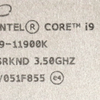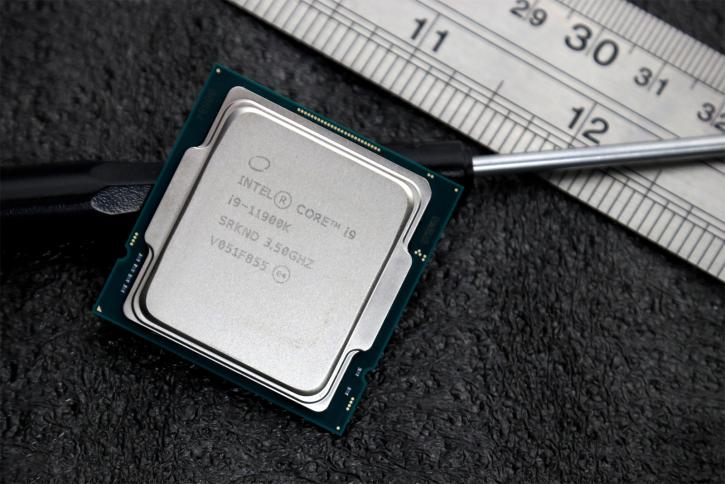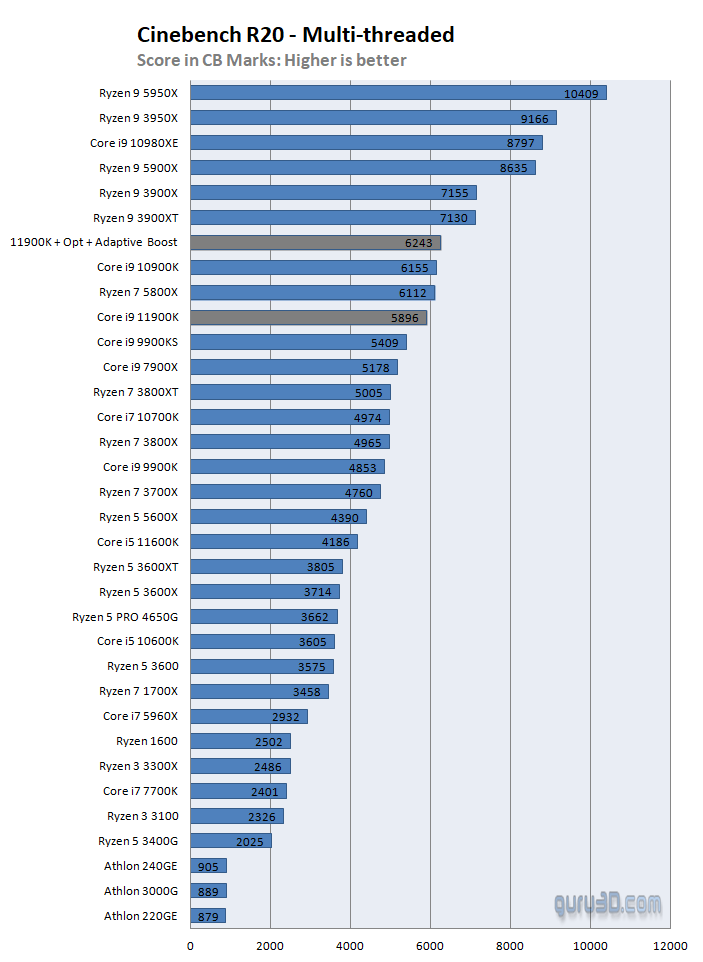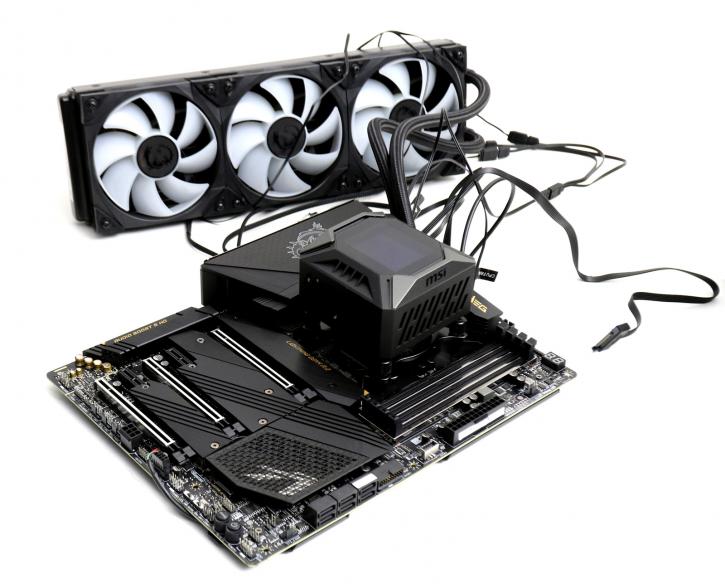Final Words & Conclusion
Final words & conclusion
With Rocket Lake, Intel has a swift desktop processor series to offer. Is it enough? Well, I guess that depends on who you ask and whether you are an AMD or Intel aficionado. The reality is simple with even the fastest unobtainable graphics cards; you'll see marginal differences with exceptions here and there with wins on both sides in between Ryzen 5000 and 11th gen Core processors. So it becomes a matter of preference. Intel undoubtedly has stepped up in IPC alright; however, 14nm fabrication is fighting against them.
Allow me to explain. The weird conundrum is that you need to realize that it is amazing that Intel can even achieve this level of performance on 14nm, on that flip side of the coin, it is also amazing that Intel is still stuck on 14nm with the shortcomings that come along with it, more unsatisfactory energy efficiency. Intel's advantage is, of course, the 5+ GHz barrier clock frequencies, combined with the extra IPC that Cypress cover offers, this brings in additional performance coming from 10th gen Comet Lake. However, it's scarcer than I expected, but enough the compete with the Ryzen 7 5800X. Performance-wise between the previous generation, there's little reason to upgrade. Today's tested product certainly is challenging the AMD Ryzen 5000 series 8-core counterparts, but each has its own advantages and disadvantages.
The excellent news is that Intel now offers PCIe Express Gen 4.0 to its real-estate. Only the 20 CPU lanes are gen 4.0 though. See, the Z590 chipset itself still sits at Gen 3.0; this also means that if you use 16 lanes for your GPU, there are only four lanes left for a PCIe Gen 4.0 SSD. Unless you share and re-distribute them, any other Gen 4.0 SSD connected to the motherboard after that will have to revert to gen 3.0. Is that a big deal? No, we don't think so. The relevancy of PCIe Gen 4.0 M2./ NVMe SSDs still is disputable at best, but in the coming year, we'll see that host infrastructure advance with much faster NVMe based SSDs, and that's where its importance will grow. A good example is our recent Sabrent M.2 SSD review, where we reached 7 GB/sec in peak performance.
The processor series does not perse require a new motherboard if you already own Z490, but again making a move from Comet to Rocket Lake really does not make sense. If you are on an older platform, it is somewhat mandatory to go with a Z590 motherboard if you want to utilize PCIe gen 4, and Z590 will not be cheap. Aside from improved VRM, doubled DMI bandwidth at 8x Gen 3.0 lanes, and USB 3.2 2x2, there really isn't much difference compared to Z490 though. So pick your battles there, I'd say.
Rocket Lake series processors will be the last one supported on the 1200-pin infrastructure. I've stated this in a recent discussion on the website and forums but considering that you upgrade a motherboard+CPU likely once every four or more years, we do not see it as incredibly significant for your purchasing decisions. But for you to upgrade, the processor needs to be just right. Later this year, Alder lake will make its introduction, with a BIG.little design, energy-friendly cores, and performance cores mixed.
Back to Rocket Lake, we do like the sharp peak performance that the series offers, but we can also tell that Intel and its motherboard manufacturers had to open up a bag of tricks to accomplish that. I am referring to the profuse turbo power states of a PL2 mode that last 57 seconds resulting in high energy consumption and heat. There's little wrong with it overall as it is not something new; however, the duration and power allowance nearly doubled up, so that means a 125 Watt TDP rated processor is allowed to jump to 225~250 Watts for almost a minute. No question about it that will influence heat, and as such, we cannot recommend mainstream heatpipe coolers; you need a proper premium cooler. LCS is the way to go as the proc running towards 250W is harsh for any cooler. The TDP as a discussion by itself, do people care about it? Not so much, we think. But sure, it is significant but manageable.
Performance & tweaking
We'd rate the new RKL 8-core part as "really good" for the results as tested. Temps/TDP remains icky to judge and will vary per motherboard. But even in the more taxing scenarios, it all is manageable when you apply LCS. We recommend the same for the more high-end Ryzen 5000 processors as both brands benefit from that nicely chilled heat spreader. At the OC levels for RKL, you are looking at 1.35V and higher needed on that CPU core for a decent tweak; however, pretty similar for AMD, tweaking 8-core or higher processors is more difficult as you are bound to run into core limitations, heat, and there it is again .. power consumption. At 5300 MHz / v1.53, we're passing 450 Watts. That's not rational by any standard. All core 5200 MHz / 1.43V draws 410 Watts (PC just CPU under load). With a processor that already runs in that 5 GHz domain, you also need to wonder if you want to tweak it at all, as really, the best configuration is already there at defaults. Regardlessly, if you like to do so, LCS will probably get you to 5.2~5.3 GHz (all cores) depending on ASIC quality, cooling, mobo, and power supply. Well, and a bit of luck and tweaking experience. Tweaking wise you increase the CPU voltage and multiplier, and you are good to go. Another plus for the Intel platform is that over the years, they have been able to refine their memory controllers, pop in anything XMP 2.0, and you have a 98% chance it'll work straight out of the box with high-speed memories. However, the effect of speedier frequency memory is far less significant, so opt volume would be my advice. We'd always suggest going with a nice affordable 3200 or a 3600 MHz kit at low latencies. Currently, we feel 3600 Mhz is the new norm and sweet-spot, though. The infrastructure that Z590 offers is sound and has proven to be reliable and easy to use. But if pricing is a thing, I'd even recommend you Z490 over Z590.
What happens when you enable motherboard optimizations & non-reference Turbo's
As explained in this article, we test processors at reference values. We disable motherboard manufacturers all-core tweaks and longer PL2 states and revert to reference. Next to that, the Core i9 11900K series now sees no less than four Turbo modes. Depending on the conditions, you can have your cores running at 5100 MHz. So, of course, one question you'll probably have is what will happen when you enable all optimizations ... we enabled them all and ran Cinebench 20:
So above, we have the reference versus the same motherboard with manufacturer tweaks and boost modes enabled. The difference is substantial. MSI, for example, applies higher all-core turbo states with their optimizations enabled. However, the 6% performance gain resulted in our 360mm LCS cooled 11900K to run at 80 Degrees C during the CB20 run. Under reference settings, the PC under load hovers at 275W~300W energy consumption (CPU load / GPU idle), but we do need to mention this; we now reached close to 420 Watts (!) power draw. Yes, you will have a faster setup, but at the cost of progressively increased energy levels and temperatures. It would help if you thought things through carefully, power supply en cooling wise.
Gaming performance
Where application testing is a bit mixed, in gaming, the CPU does show off far better then say Coffee lake. Intel and AMD are relatively close with the usual differentials and offsets on both sides from a game performance point of view, however, Intel does show the upper hand. We mentioned this many years; a GPU bottleneck is far more important to deal with and spend your money on instead of a CPU bottleneck. Intel's game performance with super-fast graphics cards solely comes into play in framerate bound situations; Intel can thank the high-frequency Turbos there, running 5.0~5.3 GHz (depending on conditions and proc). The reality remains that it's only the 1000 USD graphics cards where you can easily tackle the FPS differential with a faster GPU. Below it, you are more GPU bound. Comparing apples and oranges; some pure raw wins are for Intel and some for AMD, but everything is relative when it comes to gaming as 98% of the time, your actual limitation is the GPU and not CPU. The vast majority of you guys have a GPU limited graphics card. With eight cores, the reality is absolutely and unequivocally because you can game pretty darn and are future-proof with Rocket Lake-S. Realistically a 6-core proc offering more value will get you there as well.
Cores
Currently, I find 8-core processors a sweet spot concerning gaming, 6-cores for value, and anything higher than 8-cores in core count, overkill unless you have other demanding threaded workloads to deal with. But for gaming, 6 and 8 cores hit the G-spot; G for gaming ;)
Power consumption
With eight cores, you get a 125 Watt TDP processor. But as explained, it all is a little more complicated these days. Intel applies secondary power stages where the processor can run twice the TDP value for a pretty long time. These values will vary per motherboard manufacturers as well, as they love to offer you the best performance, so the premium board will be better tweaked (at the cost of more energy and heat). That with the IPC increase Cypress cover cores get is the holy grail for added threading performance; it does, however, make energy consumption peak with higher values during that long boost. The system at idle with a GeForce RTX 3090 installed / 16 GB memory / SSD and the Z590 motherboard hovers at roughly 65~80 Watts, depending on your motherboard's choice. That's okay, really, but the load values are significantly different. When we stressed the processor 100% run, we reach approximately 275~300 Watts with this 8-core processor (for the entire PC with GPU in idle).
Performance will vary per motherboard.
I'll say it again and make an extra chapter about it; you will notice quite a lot that results will performance vary per motherboard and brand. We've seen immensely different results, which we'll publish over the coming days in our Z590 / 11900K reviews. Settings like power and PL2 and core freq duration vary per board and brand. This was the reason why we have reset everything back to as reference as possible. Cooling will also be important in regards to performance, and not just for boost modes; a good example is that the MSI motherboards will actively ask you what type of cooling you have when you first enter the BIOS and further optimize based on your entry. Keep this in mind, as what you see here in this review is reference (well close to) performance, but a premium motherboard can bring higher performance (though at the cost of energy and heat).
Conclusion
We wish we had a clean-cut simple conclusion and answer for you in your processor options, but never has there been so much competition on the desktop processor front to hand out a preference to either brand. However, with Rocket Lake, Intel not just increases performance, they bring the platform much-desired PCIe Gen 4.0 lanes, of which four you can utilize for a super-fast NVMe SSD. Aside from double DMI link bandwidth and USB 3.2 Gen 2x2 (SuperSpeed USB 20Gbps), there is little gain from Z590 overall. A multitude of Z490 motherboards will even support PCIe Gen 4.0 as well after a BIOS update. How important the rest is to you is for you to decide. Upgrading from Comet lake is ill-advised; heck, even upgrading from a processor like a 9900K(s) remains trivial.
It truly is impressive from Intel to retrieve this level of performance at a proc fabbed at 14nm, but that positive also is negative, as the same 14nm fabrication brings challenges in heat and energy efficiency, sometimes at controversial levels depending on your motherboard configuration. You'd nearly forget that the RKL series received a healthy IPC increase; Golden cove 10nm cores have been backported to Cypress cove 14nm cores, with cache changes inside that architecture. Clock for clock AMD with ZEN3 has better IPC, though, but Intel has faster and longer-lasting high clock frequencies en energy usage levels, and that's the tradeoff between the two brands. Each of the architectures will show advantages and disadvantages. Rocket Lake overall is Intel's best-performing consumer CPU. Still, the competition tries to overshadow every move that Intel makes, and for you as a consumer, that is fantastic news as you get something to choose from. In the end, we feel the Core i9 11900K is a seriously fast and competitive processor; make no mistake about that. Whether it's enough to make a substantial difference, we can't say with certainty, as pricing is also something you need to weigh in. AMD's counterpart 5800X processor has an MSRP of 449 USD. Currently, we feel that RKL has been priced a notch too high, at 539 USD (MSRP) for the flagship 8-core part that is. You can shave off two tenners if you opt for the KF (no iGPU). You can also step down a notch to the i7-11700K at 399 USD, of course. Regardless, we'll happily hand out a recommendation if you can mentally and physically manage that power envelope and accompanying heat levels.
Handy related downloads:
- Sign up to receive a notification when we publish a new article
- Or go back to Guru3D's front page.





